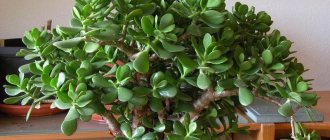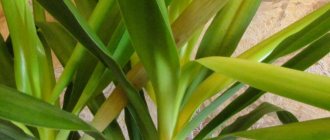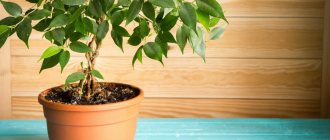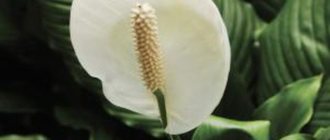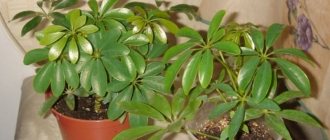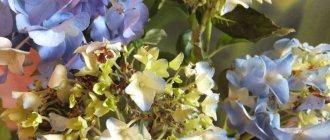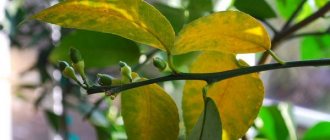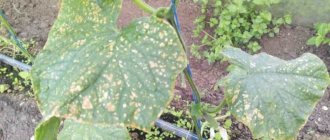Category: Succulents, Care Published 01/04/2019 · Comments: · Reading time: 10 min · Views: 1,856
Although Kalanchoe is inferior in popularity to another common succulent - aloe, it is still often found on home windowsills, and some of its varieties are highly valued in folk medicine.
Growing this plant is not difficult and even novice gardeners can cope with this task. But sometimes owners are faced with the fact that Kalanchoe leaves turn yellow and other unpleasant symptoms appear. What are the reasons for such negative changes, how dangerous are they, and how can you save a succulent?
Why do Kalanchoe leaves turn yellow and dry and what to do? Kalanchoe diseases - causes and treatment
Kalanchoe is not only a beautiful indoor plant. Its parts can be used to treat certain diseases, such as Kalanchoe Staghorn. However, the flower itself can get sick if you do not follow the rules of caring for it.
Why do Kalanchoe leaves turn yellow, dry and wither?
All diseases of a succulent are easy to notice by its appearance. If Kalanchoe leaves turn yellow, begin to dry out, curl and fall off, it means the plant is missing something.
Why do Kalanchoe leaves curl? If the leaves curl and at the same time change color to burgundy, it means that the plant is in a place that is too lit and receives direct rays for a long time during the day.
A healthy plant can not only please the eye, but also bring benefits
Violation of the conditions of maintenance and care of the plant
The main causes of problems with plant foliage are violations of the rules of caring for it. It is worth paying attention to the following points:
- Yellowing of the leaves, drying of the tips and strong upward growth indicate a lack of light. It is recommended to move the pot to a brighter place, but not in the sun;
- The constant falling of leaves occurs due to musty air. It is better to ventilate the room more often;
- dark spots on leaves often result from sunburn. When such a sign appears, you need to remove the pot to another place;
- lack of nutrients, especially after flowering, can also cause the yellow leaves on the plant to fall off;
- curling of leaf blades occurs when there is an excess amount of nitrogen or peat in the soil. The crop will need to be replanted in a more suitable soil;
- soft leaves and their falling off occurs due to excessive watering or rotting of the root system. You can cope by reducing watering or treating the root system;
- lack of irrigation can also cause shoots to fall off, the succulent can dry out, so you should regularly care for the plant;
- Excess sunlight can also cause the entire flower to turn yellow.
Pests of Kalanchoe
Homemade lemon diseases - causes and treatment
If the leaves of the Kalanchoe turn yellow or other problems appear, you may suspect attacks by dangerous pests.
Mealybug
These parasites can destroy a plant in a short time. At the same time, small gray insects appear on the bushes. Identifying them can be quite difficult. They hide in the leaves and buds of the plant during flowering.
The following signs indicate the defeat of the culture:
- leaf fall;
- waxy coating on leaves and stems;
- formation of black mold.
It is recommended to fight parasites manually. To do this, sprinkle the crop with mineral oil, and then collect the beetles with paper napkins. For prevention, the culture should be treated with a soap solution.
When mealybug attacks, leaves and branches become covered with plaque
Shchitovka
Scale insects most often attack the inside of leaves or the stem. It is a fairly large brown beetle. When attacked by parasites, the leaves of the crop quickly dry out.
To cope with insects, they need to be collected manually. To do this, you can use a cotton pad or napkins. After removing the parasites, the foliage should be wiped with an alcohol solution and treated with an insecticidal preparation.
Aphid
This is a common pest that can be very difficult to control. The cause of problems is excess fertilizer in the soil.
Aphids primarily attack shoots and the inside of leaves. Parasites absorb the juices and produce a sticky coating that prevents the plant from breathing properly. Dots also appear on the bush.
Important! When attacked by aphids, you need to remove damaged leaves and treat the crop with a soap solution. Insecticides will help speed up the treatment process.
Ticks
These pests settle on the lower part of the leaves. Their appearance is associated with increased dry air. The flower has yellowed leaves. In addition, pests weave a thin web on the foliage, causing them to curl and fall off.
Insecticides are used to control parasites. You can also remove them manually. This can be done using napkins. Then treat the bush with mineral oil. It is also permissible to use a soap solution.
Aphids settle on the underside of leaves
Kalanchoe flowers have wilted. Why is Kalanchoe dying? Mistakes in caring for Kalanchoe
Blooming Kalanchoe looks cute and pretty. Many unopened buds promise long-term flowering. You can give such a pot as a gift, or simply please yourself at home. Moreover, it is possible to please yourself and others almost all year round and for a reasonable fee. A small pot with a compact bush can easily be placed on your desktop, on a windowsill or on a shelf. We're talking about Kalanchoe Blossfeld, a common flowering hybrid species of the extensive Kalanchoe genus.
But why does a blooming Kalanchoe suddenly begin to wither, the unopened buds never blooming? Even worse, the leaves become limp and soft, droop and fall off.
As a rule, the main reason always lies in improper watering. Usually the plant is “flooded”, and for this reason the leaves become limp, the flower stalks droop, and dark hard or soft spots of fungal diseases appear on the trunk. The plant dies irrevocably.
Karakay Tatiana / Flickr.com
How to properly water flowering Kalanchoe at home? Kalanchoe is primarily a succulent, that is, it is able to accumulate moisture in its parts, in the leaves and trunk. It must be watered very sparingly, as the soil in the pot dries almost halfway. This plant will not tolerate any heavy watering. Especially if the room is cool. If the room is warm and dry, you will need to water more often. Watch the plant carefully, it will tell you when it wants to be watered. As long as the leaves are dense and the flower stalks stand straight and confident, there is no need to water the Kalanchoe, even if the top layer has dried out. And the concept of “abundant watering” means that you do not water the plant a little every day, without allowing the top layer of soil to dry out, but completely water the entire earthen ball until the water flows out of the drainage holes of the pot. Another suitable watering method for Kalanchoe is to immerse it in a container of water up to the edge of the pot. When all air bubbles disappear from the surface of the container, the pot is removed, excess water flows onto the tray, and then removed from the tray. The watered plant stands on a dry tray.
Along with watering, you need to continue to support flowering using a complex mineral fertilizer for flowering plants, for example “Agricola No. 7”, or any other.
It is not at all necessary to spray the blooming Kalanchoe. Air humidity does not matter for this plant. The degree of illumination is also of great importance for flowering Kalanchoe. In winter it should be a south window and direct sunlight. During the rest of the year, these can be the window sills of the western and eastern windows.
Brenda Dobbs/Flickr.com
Kalanchoe prefers a moderate air temperature in the room, that is, cool, but not lower than 10ºC. The flower behaves well in warm winter apartments at 22-24ºС.
It is also necessary to promptly remove faded flowers along with the peduncles. This can be done with ordinary scissors, which you disinfect and use specifically for caring for plants.
How to make Kalanchoe bloom again? It's not easy at all. This Kalanchoe is originally a species that blooms in spring. Accordingly, when we buy it blooming at other times of the year, we are buying an artificially stimulated and hormone-fed plant that was simply “forced” to bloom for the holidays. Hence all the problems with subsequent development, growth and flowering. In Europe, such plants are treated simply. They are enjoyed during the holidays, and then, when they lose their decorative appearance, they are simply thrown away. This is done with many potted plants that go on sale around the holidays, especially Christmas and New Year. This applies to the Christmas star or poinsettia, begonia, azalea, Kalanchoe and some other plants that bloom out of season or unnaturally abundantly and brightly. But if the gardener’s passion gets the better of you, then you can try to give the plant a second life. First, it needs to be sent for a period of rest. The plant needs to be radically pruned. You need to remove all flower stalks and leaves, leaving just the skeleton of the future bush, consisting of a trunk and a couple of branches. If the remaining parts of the plant begin to dry out and die, cut the Kalanchoe even lower, almost completely, leaving 3-5 cm from the trunk from the soil level. All cuts must be sprinkled with crushed coal. It is best to place the pot in a cool, shaded place with an air temperature of 10 to 16ºC. Watering should be significantly reduced.
Galina / Flickr.com
After a dormant period, the plant needs to be replanted and exposed to intense daylight. You can replant in the same pot where the plant was located. Just change the soil completely. Suitable soil for succulent plants or soil for cacti. A couple of weeks after transplantation, you need to start actively feeding them once every 14 days with mineral fertilizers for indoor flowering plants. And of course, expect a successful result of all your efforts and efforts.
Features of planting and replanting succulents
In most cases, modern indoor plants come to a new home from a flower shop or garden center. And flower growers who have no experience believe that such a green pet does not need a transplant. However, during transportation and while on the sales counter, the plants are planted in an infertile substrate, which contains a minimal amount of nutrients. And if the flower is not replanted from this poor soil mixture, after a short period of time it will begin to turn yellow due to a lack of microelements.
It is recommended to wait 1-1.5 weeks, allow the newly purchased plant to adapt and begin replanting. If the planned event takes time, then it is better to hold it in the spring. The procedure is performed according to the following algorithm:
- You should prepare a suitable soil mixture, for example, by purchasing a ready-made one at a flower shop. It is best to choose soil for succulent plants. Or you can prepare it yourself by mixing leaf soil, turf and coarse sand in equal quantities.
- It is important to choose the right container - you should not take a container that is too spacious, it should be proportionate to the succulent. A layer of drainage material is placed at the bottom of the pot - expanded clay, vermiculite or brick chips. The container must have drainage holes to allow excess moisture to escape.
- 1/3 of the pot should be filled with soil and carefully place the plant in it, straightening the roots.
- The remaining voids are filled with soil; the pot must be shaken periodically so that it settles. The soil should not be compacted; it should remain air and moisture permeable.
Upon completion of the procedure, the Kalanchoe should be watered generously with warm, settled water.
Attention! The selection of a pot of the right size should be approached with all responsibility. In a cramped tank, the succulent will not be able to develop and grow properly, and in a large tank there is a risk of soil acidification and subsequent rotting of the rhizome.
Kalanchoe has been flooded, what should I do? Watering
Kalanchoe is a succulent and is able to accumulate moisture in order to survive dry times.
And if you suddenly forgot to water the plant, then it’s okay. But excessive watering is even harmful to Kalanchoe.
When watering, the water should wet the ground thoroughly, and if there is excess left, it should be drained.
More frequent watering is allowed in the hot season, but also without excess. In winter you need to water twice a week, this will be enough, otherwise there may be rotting of the roots and the appearance of mold and fungus.
If watering is excessive
You can determine that a Kalanchoe plant has been overwatered by paying attention to the leaves:
- they will turn pale and wither,
- dark spots with yellow edges may appear,
- and the ground will always be wet.
Kalanchoe flooding is dangerous because the process of rotting roots occurs at the bottom of the pot, and we do not see it, and the result on the plant itself will be reflected late, when it can no longer be saved.
Why is Kalanchoe Bay possible?
- If you did not replant the plant after purchasing it, the purchased soil may be too moisture-intensive.
- Kalanchoe was transplanted into unsuitable soil.
- Watering too often.
- The pot with the plant is in a too dark or humid room.
- The pot does not have drainage or the pot is too spacious.
Reanimation of a flooded plant
If a flood does occur, you can try to save the plant.
- If the roots are healthy and strong, then replanting is not necessary.
- You can wrap the roots in paper so that it absorbs the liquid well, and change the paper if necessary.
You need to remove the plant from the pot and look at the condition of the roots.
Prevention
To avoid Kalanchoe diseases, it is important to follow the recommendations for caring for the flower, do not neglect the conditions of maintenance, and remember that the following are dangerous for the plant:
- drafts;
- drying out the air;
- sudden changes in temperature;
- waterlogging of the soil.
Kalanchoe should be regularly inspected in order to detect diseases or harmful insects in time. A problem noticed at an early stage is easier and faster to eradicate.
Proper care contributes to the normal development of Kalanchoe. In addition, the picky plant requires a minimum of attention:
- Water within reasonable limits . Excessive moisture can only harm the flower. The plant stores moisture for three days. In the cold season, reduced watering is required.
- Maintain a favorable temperature . The norm for Kalanchoe is from +18 to +20 degrees. The flower feels comfortable in a little coolness; heat is more difficult for it to bear.
- Create the required lighting . A bright place, out of direct sunlight, is suitable for a pot of Kalanchoe. The plant needs additional lighting when it blooms.
- Normalize air humidity . When the humidity in the environment is high, fungus and mold appear on the plant.
- The plant is planted in soil suitable for it - infertile soil to which sand and peat have been added.
- Add fertilizer in moderation . During the flowering period, Kalanchoe is fed with fertilizers no more than once a week.
The tips of Kalanchoe leaves turn yellow. Possible causes of yellowing leaves and their solutions
Almost all varieties of Kalanchoe are unpretentious and do not require any specific care. But there are situations when, even despite proper care, the flower begins to hurt: Kalanchoe leaves fall off, dry out, turn yellow, and the flowers wither.
First of all, the following reasons for yellowing of foliage are distinguished:
- incorrect landing;
- soil not suitable for the plant;
- placing a flower in an uncomfortable place for it;
- incorrect temperature conditions;
- incorrectly organized watering;
- lack or excess of fertilizers;
- flower disease, presence of pests;
- dry air;
- physiological reasons, end of the plant life cycle.
As you can see, there are plenty of reasons why Kalanchoe leaves turn yellow, dry out and fall off. In addition to the leaves, the plant's flowers may wilt and the stem may also turn yellow. And if all this does not happen because the plant has grown old and is naturally dying, then you should reconsider your principles of caring for it.
Yellowing of Kalanchoe leaves is the most common reaction of the plant to unsuitable living conditions. Leaves may turn yellow for the following reasons:
- Temperature too high;
- Incorrect lighting;
- Non-optimal watering regime;
- Very low air humidity;
- Incorrect feeding;
- Late replanting and lack of pruning.
Caring for almost any variety of Kalanchoe is simple and does not require compliance with complex rules and regulations. But there are situations when the plant begins to behave differently: the leaves dry out (most often the lower or upper leaves turn yellow), the flower withers, the leaves fall off.
If the leaves of Kalanchoe begin to turn yellow and dry, there may be many reasons for this. Among them the following points can be highlighted:
- improper watering of the flower. This is the very first and most common reason that can lead to the death of a plant if it is not detected in time. Kolanchoe is a succulent, so it should be watered rarely and not very abundantly. Any flooding can lead to rotting of the root system, which will primarily affect the condition of the leaves. To change this situation, you need to replant or simply stop watering for a while;
- excess or lack of illumination. Not all varieties of Kalanchoe can withstand direct sunlight. For this reason, the leaf blade may also turn yellow and curl. The pot should be placed in shaded areas. If the flower begins to turn yellow on top, this means there is a lack of light. In such a situation, you just need to put the pot in a more illuminated place, but at the same time avoiding direct sunlight on the Kalanchoe. If yellowing is observed evenly along the entire length of the stem, this indicates an excess of light;
- insufficient plant nutrition. All indoor flowers, due to growing in pots, need periodic feeding, since the soil tends to deplete. Applying fertilizers during the active growth phase will allow the flower not only to form beautiful buds, but also to be fully nourished. The first sign of nutrient deficiency is yellowing of the leaves. In such a situation, you only need to do one thing - apply fertilizer.
Succulent diseases
Kalanchoes are quite unpretentious and can tolerate various changes without any problems. And besides, they have strong immunity and rarely get sick, but still, sometimes it happens. Most often, diseases arise due to improper care - too frequent and abundant watering, prolonged droughts and other negative factors.
Late blight infection
With late blight, the leaves of Kalanchoe become covered with brown or grayish-brown spots and a coating consisting of fungal spores. The shoots of the affected plant become soft, flabby and die.
The main causes of the disease are waterlogging of the soil, poor ventilation and low air temperature. Treatment of a succulent consists of correcting errors - it should be placed in a warm room with dry air and the number of waterings should be reduced. Treatment of the flower with antifungal drugs is also required.
Powdery mildew
The fungus attacks flowers that lack moisture due to high air temperatures. With this disease, the foliage of the plant becomes covered with a whitish coating, reminiscent of mold. Later it turns brown, black dots appear, the leaves dry, curl and fall off. The same happens with the buds and flowers of Kalanchoe if it is blooming.
Without treatment, the succulent quickly dies. And in order to save your pet, you should normalize its habitat and use a fungicidal drug.
Gray rot
With this disease, the flower becomes covered with wet putrid spots with a grayish coating. The main reasons are dampness, poor lighting, stagnant air. Gray rot is treated in the same way as late blight.
In the case of any diseases and pests, it is important for the gardener to detect the slightest changes in the condition of the green ward and respond in a timely manner. It is much easier to cure a succulent in the early stages.
Kalanchoe leaves dry out and fall off. Problems when growing Kalanchoe
The lush flowering indoor plant Kalanchoe is very popular. The flower is undemanding, has a beautiful appearance and is endowed with healing qualities, which are actively used by traditional healers in the preparation of medicines.
But when growing Kalanchoe, gardeners often encounter serious problems - falling leaves, darkening of the tips of the foliage, the formation of dark spots, etc. All problems, as a rule, are caused by improper care. Although Kalanchoe does not require a scrupulous attitude towards itself, improper care can still cause illness and often the death of the plant.
Let's look at the most common problems that gardeners face when growing Kalanchoe.
Leaves wither
The first signal to begin active action should be the sluggish state of the flower. The Kalanchoe leaf blade softens, begins to lighten, and a little later falls off.
The reasons for leaf lethargy are the following:
- Excessive watering. Kalanchoe does not require abundant watering; on the contrary, soil moisture should be rare and limited. The leaves of the flower have the ability to accumulate moisture. If watering of the plant is limited, then its leaves are bright, dense and shiny. Overfilling of soil leads to softening of the leaf plate, disruption of the functionality of the root system and a sluggish appearance of the flower.
- Moisture deficiency. Rare and poor soil moisture is also undesirable for Kalanchoe. The leaves of the flower are simply not able to accumulate enough water to last for a long time. If a flower experiences a lack of moisture, its leaves wither, dry out and fall off.
- Watering with the “wrong” water. Moistening the soil (or spraying the foliage) with cold water often leads to lethargic foliage. It is also undesirable to water the plant with ordinary running water. The ideal water for watering Kalanchoe is left to stand for 3 days, at room temperature.
- Sunburn. Bright sunlight hitting the foliage causes burns. The first signs of foliage injury are yellowing and lethargy.
- A sharp change in climatic conditions. If a flower is moved from a warm room to a cold one (and vice versa), this will immediately affect its external condition. Until adaptation takes place, the Kalanchoe will look painful and lethargic.
How to reanimate Kalanchoe after an illness
To restore Kalanchoe after leaf disease, a soap solution is often used. Alcohol wipes are also highly effective. The procedure should be carried out three times a week.
Spathiphyllum - leaves turn yellow: causes and treatment
Instead of alcohol, it is permissible to use garlic infusion. To prepare it, you need to mix 5 crushed cloves with a glass of water, leave for 2 hours in a dark place and strain. Spray the crop with the prepared product.
When treating a plant, you should adhere to the following recommendations:
- provide the flower with complete care;
- eliminate pests in any available way;
- pinching;
- maintain normal parameters of humidity, light, temperature;
- apply fertilizers.
Thanks to strict adherence to the rules, Kalanchoe will be able to recover. On average, it is recommended to apply fertilizer once a month. Fertilizers for succulents are often used for this, but complex formulations can also be used.
Pinching prevents the crop from drying out. The procedure should be carried out with a disinfected instrument. This must be done carefully. If the bush is damaged, it should be sprinkled with charcoal.
Important! Fertilizers should be applied carefully. If there is an excess of useful elements, the plant will not withstand the rapid development of green mass.
Pest Control
Aphid. This pest is very dangerous for many plants. As a result of aphid infestation, the Kalanchoe may die completely, but before that it will begin to turn yellow and the leaves will fall off. Detecting aphids is very simple: small green insects are clearly visible to the naked eye. To get rid of aphids, you need to treat the leaves and stems of Kalanchoe with water and potassium soap.
Shield. A gray mucous coating is a sign of damage to Kalanchoe by scale insects. As a result of such parasitism, the plant can not only begin to dry out, but also become covered with fungus and mold.
To get rid of pests, you need to wipe the leaves and stems with alcohol or an alcohol-containing product.
The sooner you eliminate all pests, the greater the chance that the plant will revive and become healthy again.
Dry air
The second most common cause of yellowing of Kalanchoe leaves, especially during the heating season. Rarely does anyone think about how hot heating radiators affect a plant.
Signs. The tips of the leaves throughout the plant turn yellow and then begin to dry out entirely.
What to do. Humidify the air around the Kalanchoe as often as possible. You can do this in several ways:
- Spray with warm, clean water from a spray bottle.
- Place several additional containers with plain water around.
- Cover radiators with wet towels or blankets.
- Place a tray with expanded clay, peat or sphagnum next to it. Water them constantly.
If you do not have the opportunity to provide the Kalanchoe with normal moist air, then it is better to artificially put it into a state of rest. Place in a cool place (+14-16°C), reduce watering. The plant can remain in this position for no more than 2 months, but then you will have to come up with something to increase the humidity. Otherwise, the tips of the leaves will turn yellow.
what to do if lemon leaves turn yellow
Fighting methods
In order to permanently eliminate the cause of crown drying, as well as return the plant to a fresh, healthy appearance and lush green leaves, it is necessary to take some measures to get rid of this problem:
What to do if Kalanchoe drops its leaves?
Proper watering. This is very easy to do, since Kalanchoe is absolutely unpretentious in this matter. It is worth watering the plant if you notice that the soil is dry. Thus, in the hot season, it is worth moisturizing the flower more often than in winter.
Optimal lighting. The plant does not tolerate direct sunlight, so it is necessary to move it away from the window in case of excess light or do the opposite if there is not enough light.
You should not place Kalanchoe close to window glass, as it reflects the sun's rays and can burn the leaves.
Correct temperature conditions and sufficient air humidity. This criterion is especially important, since dry hot air is detrimental to the plant. In summer, the ideal temperature for the plant is 18-20°C, and in winter – 13-16°C. If the air is very dry, you can use special humidifiers or regularly spray the Kalanchoe with a spray bottle.
By following these recommendations, you can quickly cure Kalanchoe, and the plant will again begin to delight with its blooming appearance.
Proper care
- Kalanchoe quickly absorbs water and can store moisture inside the soil for a long period, so you should not flood the plant with water.
- In the summer, you should arrange a sunny place for Kalanchoe in an apartment or house, while in the winter, the plant can be located in its darker corners. It blooms precisely in the cold period of time.
- The optimal temperature for growth in winter is 15 degrees Celsius, while in summer it can withstand hotter climates - up to 28 degrees Celsius.
- It should be replanted as needed during the period of active revival of nature - in the spring. To do this, you will need to choose a larger pot, change the drainage and fertilize the soil.
- You can spray it from time to time to blow away dust particles.
Kalanchoe is a guest in our area, but in a short time the plant was able to adapt to its new climate and environment. It has become a favorite of many apartments and houses not only due to its medicinal quality. In winter, it pleases its owners with amazing flowering.
If you find an error, please select a piece of text and press Ctrl+Enter.
Natural wilting
Signs. The leaves sometimes turn yellow at the bottom of the stem, gradually dry out and fall off. The plant looks vigorous, grows and blooms well.
What to do. Don't change anything! Your pet is happy with absolutely everything. And the loss of a certain number of lower leaves is a normal natural aging process. You should not interfere with the usual microclimate. Kalanchoe feels great.
why do ficus leaves turn yellow and fall off?
